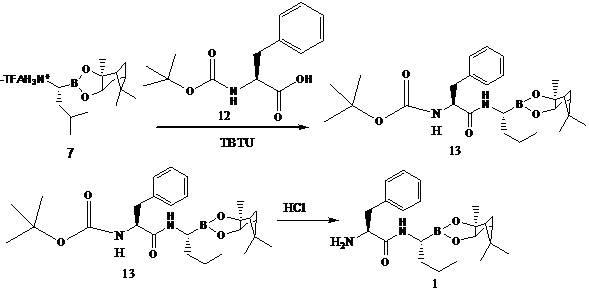Preparation of compound (1s,2s,3r,5s)-pinanediol-l-phenylalanine-l-leucine boronate
A technology of leucine borate and pinanediol, which is applied in the field of preparation of bortezomib intermediates, can solve the problems of unsuitability for industrial production, excessive three wastes, and large environmental pollution, and achieve low cost, reduction of three wastes, The effect of high yield
- Summary
- Abstract
- Description
- Claims
- Application Information
AI Technical Summary
Problems solved by technology
Method used
Image
Examples
Embodiment 1
[0015] At room temperature, triphosgene (3.6g, 12.1mmol) in tetrahydrofuran (50ml) was added dropwise to a solution of L-phenylalanine (2.0g, 12.1mmol) in tetrahydrofuran (50ml). After the addition was complete, heat to reflux for 4h.
[0016] After the reaction was completed, the reaction solution was concentrated and cooled to obtain 2.2 g of 4-benzyl-oxazolidine-2,5-dione as a solid, with a yield of 96%.
[0017] Add (1R)-(S)-pinanediol-1-trifluoroacetate-3-methylbutane-1-boronate (4.3g, 11.3mmol) and 30ml of dichloromethane into the reaction flask , cooled to -5°C. A mixture of N,N-diisopropylethylamine (6ml, 34.5mmol) and 20ml of dichloromethane was added dropwise to the above dichloromethane solution, and stirred at -5°C for 2h. 50ml of tetrahydrofuran in 4-benzyl-oxazolidine-2,5-dione was added dropwise to the above dichloromethane solution. After the addition was complete, the mixture was reacted at room temperature for 4 hours. The organic layer was washed with wate...
Embodiment 2
[0019] Add triphosgene (3.6g, 12.1mmol) in 50ml of diethyl ether dropwise to L-phenylalanine (2.0g, 12.1mmol) in tetrahydrofuran (50ml) at room temperature. After the dropwise addition, heat to reflux for 4 hours.
[0020] After the reaction was completed, the reaction solution was concentrated and cooled to obtain 1.8 g of 4-benzyl-oxazolidine-2,5-dione as a solid, with a yield of 78%.
[0021] Add (1R)-(S)-pinanediol-1-trifluoroacetate-3-methylbutane-1-boronate (3.6g, 9.5mmol) and 20ml of dichloromethane into the reaction flask , cooled to -5°C. A mixture of N,N-diisopropylethylamine (4.5ml, 28.2mmol) and 20ml of dichloromethane was added dropwise to the above dichloromethane solution, and stirred at -5°C for 2h. 40ml of 4-benzyl-oxazolidine-2,5-dione in tetrahydrofuran was added dropwise to the above dichloromethane solution, and after the addition was complete, the mixture was reacted at room temperature for 4h. The organic layer was washed with water, and the organic la...
Embodiment 3
[0023] At room temperature, triphosgene (7.2g, 24.2mmol) in tetrahydrofuran (50ml) was added dropwise into a solution of L-phenylalanine (4.0g, 24.2mmol) in tetrahydrofuran (50ml). After the addition was complete, it was heated to reflux for 4h.
[0024] After the reaction was completed, the reaction solution was concentrated and cooled to obtain 3.7 g of 4-benzyl-oxazolidine-2,5-dione as a solid, with a yield of 85%.
[0025] Add (1R)-(S)-pinanediol-1-trifluoroacetate-3-methylbutane-1-boronate (7.4g, 19.4mmol) and 60ml of dichloromethane into the reaction flask , cooled to -5°C. A mixture of N,N-diisopropylethylamine (9.6ml, 58.2mmol) and 40ml of dichloromethane was added dropwise to the above dichloromethane solution, and stirred at -5°C for 2h. 50ml of tetrahydrofuran in 4-benzyl-oxazolidine-2,5-dione was added dropwise to the above dichloromethane solution. After the addition was complete, the mixture was reacted at room temperature for 4h. The organic layer was washed w...
PUM
 Login to View More
Login to View More Abstract
Description
Claims
Application Information
 Login to View More
Login to View More - R&D
- Intellectual Property
- Life Sciences
- Materials
- Tech Scout
- Unparalleled Data Quality
- Higher Quality Content
- 60% Fewer Hallucinations
Browse by: Latest US Patents, China's latest patents, Technical Efficacy Thesaurus, Application Domain, Technology Topic, Popular Technical Reports.
© 2025 PatSnap. All rights reserved.Legal|Privacy policy|Modern Slavery Act Transparency Statement|Sitemap|About US| Contact US: help@patsnap.com

